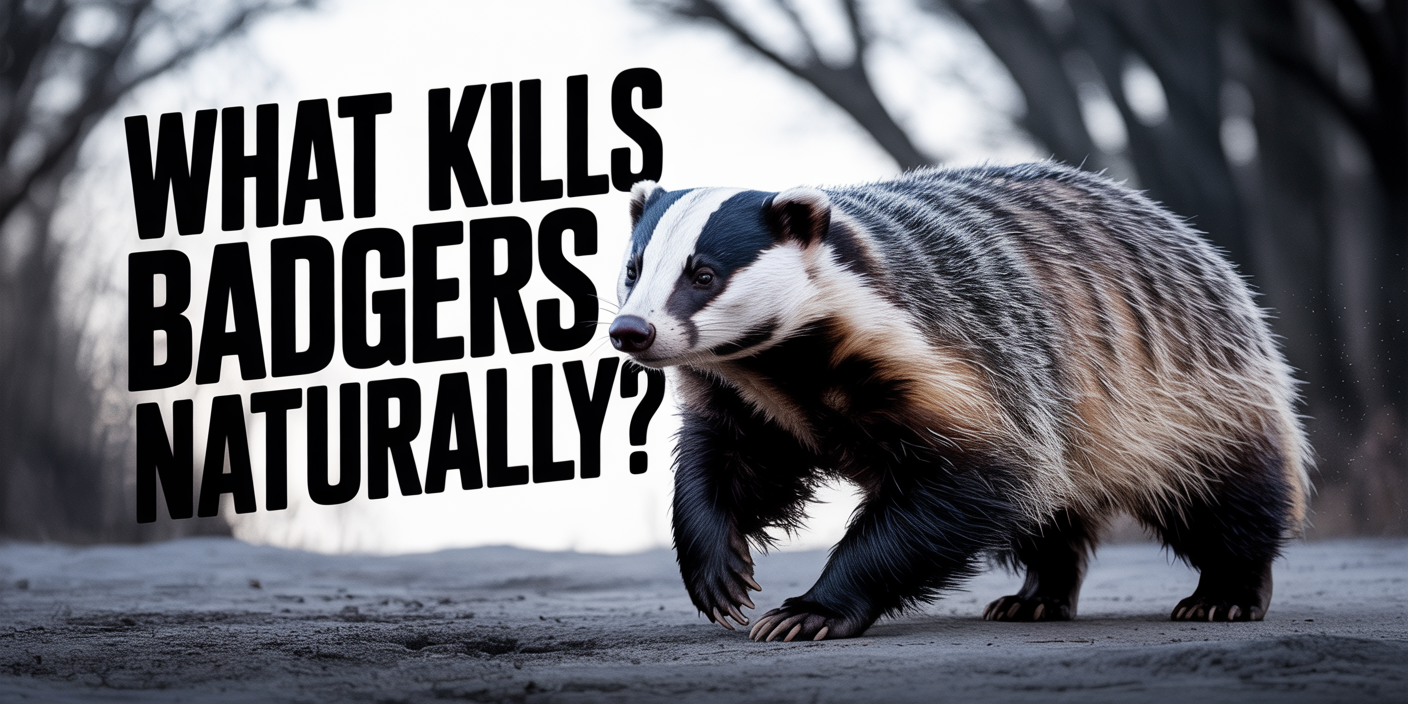“What kills badgers naturally? Predators like coyotes, mountain lions, and bears, along with harsh environmental factors such as extreme heat, drought, and disease.”
When Phoenix residents think about wildlife nuisances, badgers might not top the list—but they do show up in Arizona’s desert ecosystems, including areas around Maricopa County. Known for their strong digging abilities and solitary habits, badgers can become a real concern when they start burrowing near homes, golf courses, or commercial properties. Understanding what kills badgers naturally helps shed light on their role in the local environment and why humane management matters.
At AAAC Wildlife Removal, we specialize in safe and ethical wildlife control services for the Phoenix area, including badger-related issues. While natural predators and environmental challenges do affect badger populations, it’s essential for property owners to focus on responsible solutions rather than harmful ones. In this post, we’ll walk through what naturally controls badger numbers, the risks they face in Arizona, and how our team can help manage badger problems without putting the local ecosystem at risk.
What Naturally Controls Badger Populations?
Badgers may seem tough, but nature definitely has its ways of keeping their numbers in check. Around Phoenix and the broader Arizona desert, several natural factors contribute to badger population control. Here’s what typically affects them:
- Predators:
Coyotes, mountain lions, and bears can prey on badgers, especially young or injured ones. While adult badgers are aggressive, they’re not completely off the menu for these larger animals. - Diseases:
Illnesses such as canine distemper, bacterial infections, and other wildlife-borne diseases reduce badger survival rates in the wild. - Parasites:
Ticks, fleas, and internal parasites like worms weaken badgers over time, making them more vulnerable to predators or harsh conditions.
At AAAC Wildlife Removal in Phoenix, we respect these natural processes while focusing on humane and ethical badger management when they wander into neighborhoods. Instead of harming them, we help relocate them safely to protect both the animals and local property.
Can Badgers Die From Environmental Factors?
Badgers may be naturally equipped for desert life, but Arizona’s environment doesn’t always make survival easy. In the Phoenix area, extreme heat and prolonged drought can push badgers to their limits. Even though they’re adapted to dry conditions, a lack of water sources combined with rising temperatures can reduce their access to food and shelter, leaving them vulnerable to dehydration and starvation. These environmental factors naturally influence badger populations without human involvement.
On top of heat and drought, habitat loss plays a major role. As Phoenix and surrounding cities continue to grow, construction and development replace the open spaces badgers rely on for hunting and burrowing. This leads to food scarcity as prey animals become harder to find in smaller, fragmented habitats. At AAAC Wildlife Removal, we’ve seen firsthand how these challenges can bring badgers into closer contact with people, which is why we focus on humane relocation rather than harmful control methods.
What Animals Kill Badgers in Arizona?
While badgers are strong and known for their defensive behavior, several larger predators in Arizona can take them down, especially if the badger is young, sick, or injured. In the Phoenix area, these natural predators help maintain balance in the local ecosystem. Here are the main animals that can kill badgers naturally:
- Coyotes:
Common around Phoenix’s outskirts, coyotes may attack badgers if food is scarce or the opportunity presents itself. - Mountain Lions:
Found in Arizona’s higher elevation and more remote desert areas, mountain lions are powerful enough to prey on badgers. - Bobcats:
Though smaller than mountain lions, bobcats have been known to take on badgers under the right conditions. - Bears:
Less common in central Arizona but still present in parts of the state, bears can also pose a threat to badgers.
Alongside these predators, human-related risks like vehicle collisions and habitat loss are actually a bigger concern for badgers in populated areas like Phoenix. That’s why AAAC Wildlife Removal focuses on humane relocation rather than harmful methods when handling badger issues around homes and businesses.
Are Badgers at Risk From Human Activity?
While natural predators play a role in badger survival, human activity poses a much larger threat—especially in fast-growing areas like Phoenix. One of the most common risks comes from vehicle collisions, particularly near roads that cut through desert habitats. Habitat loss from housing developments, commercial buildings, and road construction also forces badgers into smaller areas with fewer resources, making survival even harder.
Beyond accidental dangers, some people mistakenly attempt to control badger activity through harmful trapping or poisoning. That not only puts badgers at risk but can also affect other wildlife and pets in the area. AAAC Wildlife Removal always follows Arizona’s wildlife regulations, ensuring badgers are handled safely and ethically. Instead of resorting to harmful methods, our team helps property owners manage badger problems with humane solutions that respect both the animals and the local environment.
How Does AAAC Wildlife Removal Handle Badger Issues?
1. Property Assessment
Before any removal begins, AAAC Wildlife Removal conducts a detailed property inspection to spot signs of badger activity. This includes checking for burrows, tracks, soil disturbances, or damaged structures that suggest where badgers may be nesting or hunting.
Once we gather that information, we create a tailored removal plan based on your specific property layout and badger behavior. By understanding both the animal’s patterns and the unique challenges of your Phoenix home or business, we ensure a safer, more effective removal process.
2. Humane Trapping Techniques
We prioritize humane trapping methods that capture badgers without causing injury or unnecessary stress. AAAC Wildlife Removal uses live traps specifically designed for larger wildlife, making sure the process stays safe for both animals and people.
Our team follows strict Arizona wildlife handling guidelines throughout trapping. This approach protects the local ecosystem while giving property owners peace of mind, knowing the badger is being removed responsibly rather than harmed or left untreated.
3. Professional Removal
Once a badger is captured, AAAC Wildlife Removal transports it to a more suitable natural environment away from Phoenix neighborhoods. This careful removal process helps protect both the animal and local communities from potential future encounters.
We don’t just remove the badger and walk away—we also assess follow-up needs to make sure the problem doesn’t repeat itself. By pairing professional removal with proactive solutions, we offer long-term peace of mind for property owners.
4. Habitat Modification
After the badger has been removed, our team looks for ways to make your property less inviting to future wildlife. This might include sealing burrow entrances, adjusting landscaping, or advising on property features that could attract badgers.
These habitat modification strategies focus on prevention rather than just solving one-time issues. It’s all about helping Phoenix homeowners and business owners avoid recurring wildlife problems in a way that’s safe and effective.
5. Compliance With Arizona Wildlife Laws
AAAC Wildlife Removal operates with full awareness and respect for Arizona’s wildlife laws. From trapping to final removal, every step we take follows state regulations and local guidelines to ensure legal compliance.
By choosing AAAC Wildlife Removal, you’re not only getting professional service—you’re also choosing an approach that protects both wildlife and community interests. It’s about solving problems the right way, without risking fines or ecological harm.
Conclusion: Keeping Badgers and Phoenix Properties Safe
While badgers in Arizona face natural threats from predators, harsh environments, and disease, human activity poses the biggest risk to their survival—especially in growing areas like Phoenix. Understanding what kills badgers naturally helps highlight why humane wildlife control is so important. These animals play a role in maintaining ecological balance, so it’s worth handling badger encounters with care and responsibility.
If you’re dealing with badger activity on your property or have questions about safe removal, AAAC Wildlife Removal is here to help. Our team provides ethical, effective solutions tailored to Phoenix homeowners and businesses. Contact AAAC Wildlife Removal today to learn more about managing badger problems the right way—safely and professionally.




